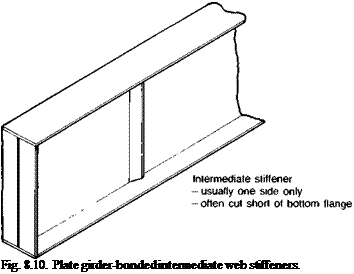Plate structures which have been stiffened by the addition of welded attachments can suffer from the problems of distortion and inferior fatigue performance outlined. The use of adhesive to unite the stiffener and the plate has been the subject of considerable research interest, and shows much promise. Harvey and Vardy(14) reported on an investigation into the performance of bonded shear stiffeners on plate girders (Fig. 8.10), whilst Hashim et al. (15) have examined the potential for using bonded stiffened plates in ship hulls. In the former research work a number of half-scale girders were built and tested with over — and under-sized bonded T-stiffeners (Fig. 8.11); the failure loads were somewhat higher than those predicted by finite element modelling. In addition to the buckling tests performed on complete girders, a number of fatigue tests were also carried out on specimens mimicking the web/stiffener cross-section. This work was very encouraging, and a number of further opportunities would seem to exist with the addition of stiffeners to existing structures.
With bonded joints involving relatively thick stiff steel sections the strength and performance of such joints is governed largely by the adhesive’s properties. The need for rigidity and performance at higher temperatures than with concrete structures dictates the use of stiff high performance adhesives. So far, single-part heat-cured toughened epoxides have been identified as suitable products. Gritblasting of the adherend prior to bonding, perhaps with the addition of a silane primer, should ensure satisfactory long-term performance.
 |
End or bearing stiffener
— must be both sides
— must fit to both flanges
 20 сентября, 2015
20 сентября, 2015  Malyar
Malyar  Опубликовано в рубрике
Опубликовано в рубрике 